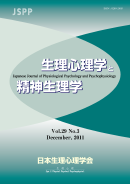Volume 19, Issue 3
Displaying 1-7 of 7 articles from this issue
- |<
- <
- 1
- >
- >|
-
2001Volume 19Issue 3 Pages 89-90
Published: December 31, 2001
Released on J-STAGE: November 27, 2012
Download PDF (213K) -
2001Volume 19Issue 3 Pages 91-92
Published: December 31, 2001
Released on J-STAGE: November 27, 2012
Download PDF (246K) -
2001Volume 19Issue 3 Pages 93-94
Published: December 31, 2001
Released on J-STAGE: November 27, 2012
Download PDF (336K) -
2001Volume 19Issue 3 Pages 95-103
Published: December 31, 2001
Released on J-STAGE: November 27, 2012
Download PDF (1584K) -
2001Volume 19Issue 3 Pages 105-203
Published: December 31, 2001
Released on J-STAGE: November 27, 2012
Download PDF (16453K) -
2001Volume 19Issue 3 Pages 205-215
Published: December 31, 2001
Released on J-STAGE: November 27, 2012
Download PDF (1767K) -
2001Volume 19Issue 3 Pages 217-225
Published: December 31, 2001
Released on J-STAGE: November 27, 2012
Download PDF (1187K)
- |<
- <
- 1
- >
- >|
